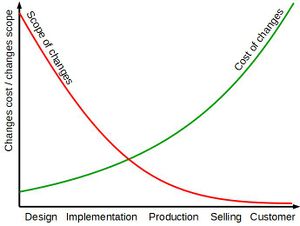Designed quality
| Designed quality |
|---|
| See also |
By the designed quality (also known as: quality of design, design for quality, quality of type) we understand the extent to which quality standard described in the product design meets the expectations of users (consumers). The quality of the product generally consists of:
- designed quality and
- quality of conformance (quality of production).
There is a relation between designed quality, technical level and quality costs:
- The higher the designed quality, at the technical level, the quality costs are higher, due to the increase in the cost of good quality.
- Technological advances can, however, cause a reduction in production costs and the improvement of the designed quality will be accompanied by quality cost reduction.
Improvement of technology must be accompanied by economic calculation. We must remember that quality is a relative concept, depending not only on the characteristics of the product, but also the needs and financial possibilities of the recipient. Therefore, also the relationship as well as price elasticity of demand with respect to quality, must be assessed in a way or estimated separately for each group of recipients.
To achieve high quality of design, enterprise should use appropriate methods, like Failure Mode and Effects Analysis or Quality Function Deployment. In case of services, designed quality can be improved using SERVQUAL method.
Rules of design for quality
D.M. Anderson in his book proposed rules of design for quality:
- Observe quality and reliability design guidelines.
- Raise and resolve issues early.
- Use Multi-functional teamwork.
- Utilize Quality Function Deployment.
- Do thorough up-front work.
- Simplify the design.
- Minimize the exponential cumulative effect of part quality and quantity.
- Select the highest quality processing.
- Optimize tolerances (Taguchi method → Quality loss function).
- Utilize Poka yoke, prevent mistakes by design.
- Proactively minimizing all types of risk.
- Base metrics and compensation on Total Cost and Time to Stable Production.
- Reusing proven designs.
- Document thoroughly and completely.
- Thoroughly design the product right the first time.
Designed quality according to W. Edwards Deming
William Edwards Deming recommended the focus of the company on a long-term planning. He considered that its absence creates a major obstacle to the development of the organization in a competitive market. Long-term planning should include within its scope primarily:
- attractive new products and services,
- new materials for the production of those products,
- new production technologies,
- new professions and qualifications structure of the crew in conjunction with its recruitment,
- costs of production, market organization and user support,
- modernization of products and services in conjunction with the system of incentives and improving training,
- allocations of funds for the operation and development of fixed assets.
The starting point of long-term planning is to determine the level of designed quality, new products and services attractive on future market. This is the source of success.
New concepts improvement of designed quality
New concepts improve the designed quality arise from three sources:
- marketing research that should provide information on the desirable traits of individual products and their intensity in different markets, allowing them to redesign in order to improve their level of quality,
- inventions and improvements in process technology and product being the result of basic scientific discoveries that create the possibility of re-manufactured products, or design a new product in search of better meet the needs of a competitive market,
- announcement and introduction of new critical requirements (marginal) product posed by law (e.g. the directive called. 'New Approach', European standards, etc.) compels the producer to seek new solutions in the field of production technology, products and their use.
References
- D.M. Anderson, Design for Manufacturability: How to Use Concurrent Engineering to Rapidly Develop Low-Cost, High-Quality Products for Lean Production 2014
- Bansiya J, Davis CG (2002) A hierarchical model for object-oriented design quality assessment, Software Engineering, IEEE Transactions on, 28:1
- Gann D, Saiter A, Whyte J (2003) Design Quality Indicator as a tool for thinking, Building Research & Information, Volume 31, Issue 5
- Latzko W.J., Sanders D.M., Four days with dr. Deming, 1998
